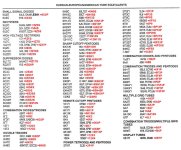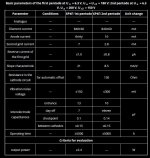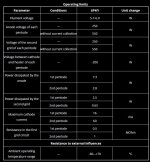I have a Russian tube that looks like it might be a dual pentode in a 9-pin package, with a husky pentode and what looks to be a lower power pentode. the number looks like it might be 6P4P, though I'm not sure about the cyrillic character at the end. Does this ring a bell with anyone?
https://rudatasheet.ru/tubes/6r4p/?ysclid=lv0jp8hair548507821
They speak of it like
this - 6p4P is a curve lamp. The curve is firstly that one pentode is powerful, the other is weak. VA caracter is not a gift either. One pentode with a short characteristic for AGC circuits in receiving/transmitting equipment.
Secondly, it needs a 10-legged panel, which you just can't find yet.
They speak of it like
this - 6p4P is a curve lamp. The curve is firstly that one pentode is powerful, the other is weak. VA caracter is not a gift either. One pentode with a short characteristic for AGC circuits in receiving/transmitting equipment.
Secondly, it needs a 10-legged panel, which you just can't find yet.
I may have some 10-pin sockets floating around in my stash. If the small pentode is remote cutoff, that might complicate matters - otherwise, I would use it in Schade configuraton to make a small SE amplifier.
It's easier to take . 6Р4П It was used in one TV model. Very ancient.
Analog
https://www.radiomuseum.org/tubes/tube_efl200.html
Analog
https://www.radiomuseum.org/tubes/tube_efl200.html
Attachments
Last edited:
I was thinking of using this in a headphone amplifiier, but a lot would depend on the characteristics of the small pentode. Both tubes are rather slippery in terms of transconductance (especially the larger pentode, as it appears to be designed for video amp duty), so a partial "Schade" feedback scheme might be a bit problematic without some compensation for the inner loop.
Last edited:
It is 10-pin (!) voltage amplifier pentode combined with audio power pentode. There are no sockets for such tube.
The power pentode is low voltage low Rp akin to 50L6, but with much higher transconductance.
The power pentode is low voltage low Rp akin to 50L6, but with much higher transconductance.
Last edited:
The comparison table in post 2 was published by me in Glass Audio some 30 years ago.
At the time Russian tubes were new to us and it was hard to find cyrillic characters for my
computer (probably CPM or early MS-DOS). It was Volume 7 Number 5 1995.
Somebody added the red numbers. I am not responsible for anything concerning these red
additions.
Edit : this comparison table appeared in a later issue I think.
At the time Russian tubes were new to us and it was hard to find cyrillic characters for my
computer (probably CPM or early MS-DOS). It was Volume 7 Number 5 1995.
Somebody added the red numbers. I am not responsible for anything concerning these red
additions.
Edit : this comparison table appeared in a later issue I think.
Last edited:
T already have a line to the tube data - it appears to be a Russian sub for the 6Y9/EFL200 - have the datasheets for both.
Probably equivalent to european EFL200 / PFL200
https://frank.pocnet.net/sheets/010/p/PFL200.pdf
although it can be used for A.G.C the small signal pentode is imho not a remote cutoff;
that gm varies between 2 and 8 mA/V between 1 ... 10 mA plate current does not necessarily mean it is remote;
an EF80 behaves similarly
the translated russian d.s. has no curves though ...
https://frank.pocnet.net/sheets/010/p/PFL200.pdf
although it can be used for A.G.C the small signal pentode is imho not a remote cutoff;
that gm varies between 2 and 8 mA/V between 1 ... 10 mA plate current does not necessarily mean it is remote;
an EF80 behaves similarly
the translated russian d.s. has no curves though ...
Attachments
I will have to deal with the no-curves issue by winging it with the screen voltage and bias resistors for both sections.. I'm thinking of using 150V plate voltage for both sides.
It turns out I have data on the 6Y9, which is the American version of this tube, in my re-issue of the Sylvania tube manual, but unfortunately, no curves.
The d.s. of the european eqivalent has many curves ...
https://frank.pocnet.net/sheets/010/p/PFL200.pdf
https://frank.pocnet.net/sheets/010/p/PFL200.pdf
Last edited:
The series heated sibling PFL200 was very common in European b/w TV sets from the late 1960ies.
Best regards!
Best regards!
- Home
- Amplifiers
- Tubes / Valves
- Russian Tube ID

![20240414_223852[1].jpg](/community/data/attachments/1206/1206961-a3648bf19b1fe82701085e470dcdcb14.jpg?hash=o2SL8Zsf6C)



